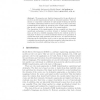Free Online Productivity Tools
i2Speak
i2Symbol
i2OCR
iTex2Img
iWeb2Print
iWeb2Shot
i2Type
iPdf2Split
iPdf2Merge
i2Bopomofo
i2Arabic
i2Style
i2Image
i2PDF
iLatex2Rtf
Sci2ools
GG
2008
Springer
2008
Springer
Pattern-Based Model-to-Model Transformation
We present a new, high-level approach for the specification of model-to-model transformations based on declarative patterns. These are (atomic or composite) constraints on triple graphs declaring the allowed or forbidden relationships between source and target models. In this way, a transformation is defined by specifying a set of triple graph constraints that should be satisfied by the result of the transformation. The description of the transformation is then compiled into lower-level operational mechanisms to perform forward or backward transformations, as well as to establish mappings between two existent models. In this paper we study one of such mechanisms based on the generation of operational triple graph grammar rules. Moreover, we exploit deduction techniques at the specification level in order to generate more specialized constraints (preserving the specification semantics) reflecting pattern dependencies, from which additional rules can be derived.
GG 2008 | Lower-level Operational Mechanisms | Theoretical Computer Science | Triple Graph | Triple Graph Constraints |
| Added | 09 Nov 2010 |
| Updated | 09 Nov 2010 |
| Type | Conference |
| Year | 2008 |
| Where | GG |
| Authors | Juan de Lara, Esther Guerra |
Comments (0)

